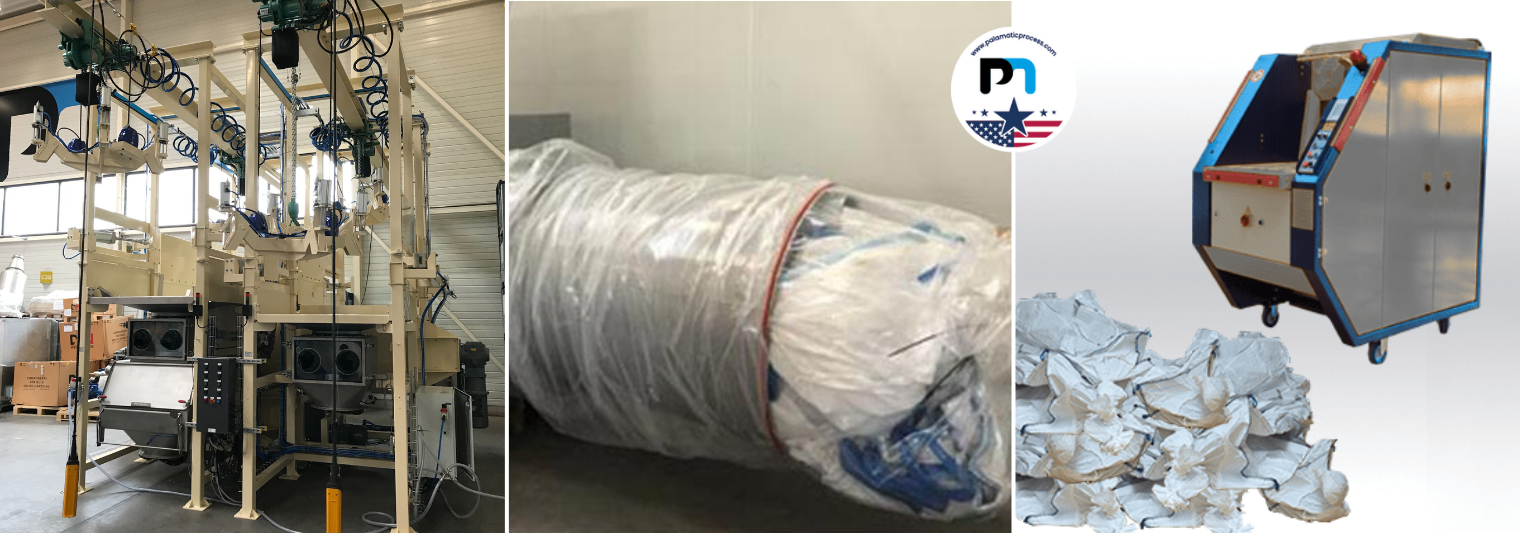
Across many industries, bulk bags and sacks are widely used for the transportation, filling, and storage of powders and bulk materials. However, once emptied, these bulk bags can pose significant logistical challenges due to their bulkiness, transportation costs, and the complexity of handling them as industrial waste.
Reducing their volume has become a necessity to optimize production areas, streamline logistics, and minimize disposal costs. Various solutions are available to achieve this goal, such as ensuring complete emptying of bulk bags or sacks to improve compaction, and using the right technologies like mechanical compacting or shredding to reduce their size.
1. Why is it important to reduce the volume of empty bulk bags ?
Empty bulk bags occupy significant space in storage areas and production zones, which can lead to handling challenges and disrupt the organization of industrial workflows. Additionally, transporting them as-is leads to logistical inefficiencies, since they consume large volumes without carrying any product. Managing bulky materials and waste also results in higher operational costs, particularly related to removal and treatment of used bulk bags.
Reducing their volume offers key advantages:
- Optimize storage space by reducing congestion in production zones.
- Cut logistics costs by lowering transportation expenses.
- Minimize carbon footprint by reducing the number of trips for waste removal.
- Decrease airborne dust in production areas by limiting handling of soiled bulk bags.
Improving the compacting and recycling of bulk bags and sacks can lead to significantly more efficient material flow and make bulk bag filling operations cleaner, safer, and more effective.
2. Proper emptying of bulk bags: a key prerequisite
A bulk bag that isn’t properly emptied can retain residual product or material, leading to several issues. First, it results in product waste, generates significant dust during handling after unloading, and increases material losses, which is especially problematic for high-value raw materials.
In addition, a bulk bag that still contains leftover product is more difficult to compact because the residual material prevents optimal compression. Depending on the compaction technology used, this can also lead to dust emissions. Moreover, in cases where the bulk bags are reused or recycled, incomplete emptying can result in cross-contamination risks between different products during refilling.
Several challenges can hinder a complete discharge. Greasy powders tend to cling to the bag’s fabric, making removal difficult. Caked products often require lump breaking before they can be emptied entirely, while fine and volatile powders may stick to the PE liner inside the bag, reducing the overall discharge efficiency.
To overcome these challenges, using high-performance bulk bag unloaders is essential. These systems offer:
- Smoother product flow with integrated vibrators and massaging devices.
- Optimized discharge through integrated industrial vacuum units.
- Reduced product loss thanks to dust containment rings that capture fine particles.
- Improved productivity with automatic bulk bag opening systems.
Ensuring a complete discharge is a key step in maximizing compaction efficiency and reducing unnecessary waste.

Do you have a bulk bag handling project ?
I'm available to help guide you through your analysis and provide expert support.
Guillaume, expert in bulk bag compaction
3. What are the solutions for reducing the volume of empty bulk bags ?
One of the most effective ways to reduce the volume of empty bulk bags is by using a compactor. This device compresses the bulk bags, reducing their size by as much as 80%. It helps free up warehouse space, simplifies storage, and reduces transportation and disposal costs.
There are different types of compaction technologies:
- Mechanical compactors: These systems apply pressure to compress bulk bags into a liner. They're ideal for low-volume operations or industries processing a limited number of used bulk bags.
- Hydraulic and pneumatic compactors: These units deliver stronger and faster compression, allowing for the processing of a larger number of bags in a shorter period of time.
- Hydraulic knife shredders: These machines shred bulk bags into small fragments that can be vacuum-transferred to a storage hopper. Some models include a hydraulic press that compacts shredded waste directly before it's placed in a bin.
The benefits of these solutions include:
- Significant space savings in warehouses.
- Easier waste removal to recycling facilities.
- Elimination of manual handling, enhancing operator safety.
- Lower dust levels in production areas—an important factor for ATEX zone classification.
Optimizing waste removal becomes easier since shredded bulk bag fragments take up less space and are easier to transport to treatment centers.
4. Alternatives to compacting: cleaning and reusing bulk bags
In some industries, reusing bulk bags may be a more viable option than compacting or disposal. The ability to reuse a bulk bag depends on its classification:
- Class 1: Single-use only, must be replaced after each cycle.
- Class 2: Can be reused up to five times with quality control checks between each use.
- Class 3 and 4: Designed for up to twenty reuse cycles, provided proper cleaning and certification are performed.
Specialized companies offer bulk bag cleaning services to extend bag lifespan. The process typically involves vacuuming and high-pressure air blowing to remove powder residue and contaminants without damaging the bag structure. Once cleaned, the bags are folded and shipped back to powder manufacturers. If the bags are equipped with internal liners, the service provider replaces them to ensure no cross-contamination occurs. This method is highly effective and often results in a lower cost per bag compared to buying new ones.
Key benefits of bulk bag reuse include:
- Reduced industrial waste by decreasing the need for new bulk bags and sacks.
- Lower purchasing costs through longer service life.
- Eco-friendly approach that lessens environmental impact.
- Less transport required, avoiding long-haul logistics from manufacturers based in Turkey, India, or China.
This solution offers both cost optimization and an active contribution to more sustainable resource management, particularly when accounting for the weight of empty bulk bags.
5. Conclusion
Reducing the volume of empty bulk bags and sacks is a critical concern for many industries, driven by both economic and environmental factors. By ensuring complete emptying of bulk bags and implementing appropriate compaction technologies, businesses can streamline waste management and cut logistics costs.
For companies looking to reduce their environmental footprint, reusing bulk bags through specialized cleaning services is a viable and sustainable alternative. With the right strategy in place, it's possible to enhance industrial efficiency, minimize costs, and support more responsible logistics operations.
Looking to improve the way you manage empty bulk bags ? Explore our solutions for compacting, shredding, and cleaning, and contact our bulk bag experts to find the right fit for your operations.
















